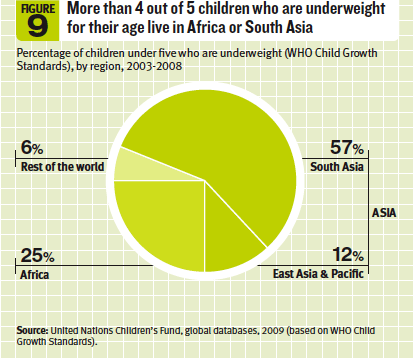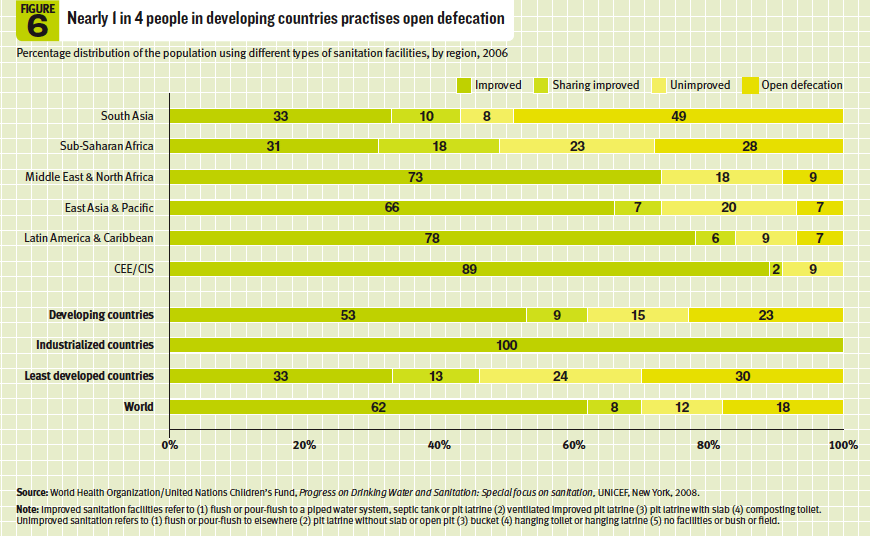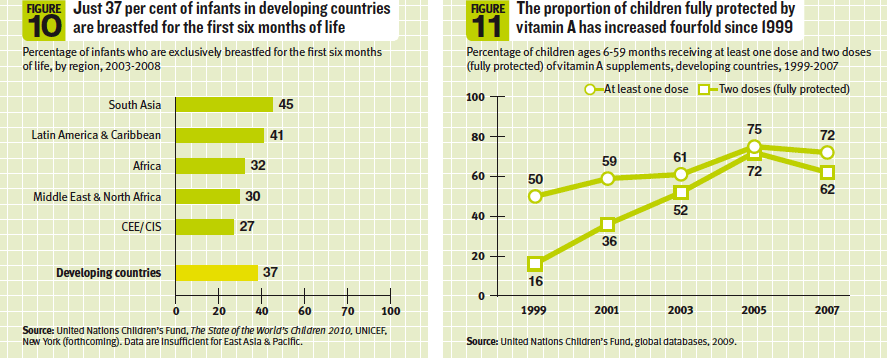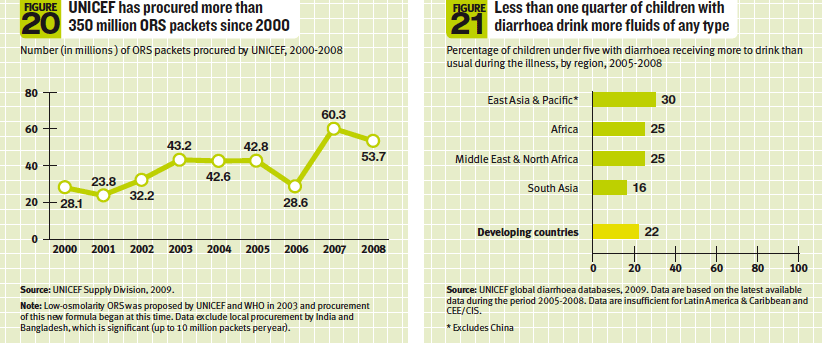7 Point Plan
Preventing and treating childhood diarrhoea: Where we stand today
 This section provides an update on how well countries and regions are doing in making available key measures to prevent and treat childhood diarrhoea.
This section provides an update on how well countries and regions are doing in making available key measures to prevent and treat childhood diarrhoea.
Prevention
Water, sanitation and hygiene
Improving access to safe drinking water and adequate sanitation, as well as promoting good hygiene, are key components in preventing diarrhoea. Yet a recent WHO/UNICEF report
36 indicated that, in 2006 (the latest year for which data are available), an estimated 2.5 billion people were lacking improved sanitation facilities. Moreover, nearly 1 in 4 people in developing countries were practising indiscriminate or open defecation (Figures
6 and
7). To further compound the problem, children’s faeces are often unsafely disposed of in many developing countries.
37 Children’s stools tend to carry a higher pathogen load than adults’, and many children play in areas in which stools are found. Safely disposing of them is therefore critical for reducing the number of diarrhoea cases.
Between 1990 and 2006, the proportion of the developing world’s population using an improved drinking water source rose from 71 per cent to 84 per cent (
Figure 8). Still, almost 1 billion people lack access to improved drinking water sources, and many households do not treat or safely store their household water supplies. Rural access to improved drinking water sources remains low, and many people using an improved source must still walk long distances to fetch water, thereby reducing the amount collected. While coverage is higher in urban areas, population growth presents a growing challenge in further increasing improved drinking water coverage. The lack of improved drinking water sources also tends to curtail personal hygiene practices, including handwashing.
Data on handwashing with soap are not available through major national-level household surveys
due to concerns about the validity of information provided by responders. However, proxy indicators
such as the availability of soap and other commodities in the household for use in handwashing
will be added to the next round of surveys, including the UNICEF-supported Multiple Indicator Cluster Surveys.
 Adequate nutrition
Adequate nutrition
Undernourished children are more likely to suffer from diarrhoea and its consequences, which, in
turn, increases their chances of worsening nutritional status. Today, 129 million children under the
age of five in the developing world are underweight for their age. Together, Africa and South Asia
account for more than 80 per cent of total underweight children (25 per cent and 57 per cent,
respectively) (
Figure 9). About 40 per cent of children under five years of age are stunted in Africa,
and nearly half in South Asia.
Breastfeeding
Over the past decade, there has been some progress in exclusive breastfeeding rates among infants in
the first six months of life across the developing world, and particularly in Africa. Despite these
advances, overall levels remain low, and only 37 per cent of infants in developing countries are
exclusively breastfed for the first six months of life (Figure 10).
Micronutrient supplementation
Vitamin A supplementation rates have increased significantly in recent years. Coverage of children
aged 6-59 months with at least one dose of vitamin A per year has increased by nearly 50 per cent since
1999. Moreover, between 1999 and 2007, coverage of children considered fully protected by vitamin
A – that is, receiving two doses per year – increased nearly fourfold in developing countries (Figure 11).
Progress was made possible through innovative strategies that included combined delivery with
other high-impact interventions for health and nutrition. Reaching the poorest children and those living in rural areas, who are most at risk of vitamin
A deficiency, remains the greatest challenge.
Zinc is important for normal growth and development and for reducing childhood diarrhoea cases.
Yet data on improving children’s zinc status as a key prevention measure are not available.
Immunization
Only a few, mostly high- and middle-income countries include rotavirus vaccine in their routine
immunization schedules. WHO recently recommended introduction of the vaccine in all routine
schedules, and data to monitor its coverage in many countries are expected to follow implementation.
Deaths due to measles have declined rapidly in recent years. Between 2000 and 2007, global mortality
attributed to measles was down by 74 per cent.38
This decrease in deaths is generally credited to increases in routine measles immunization coverage,
coupled with improvements in follow-up campaigns that provide second opportunities for children to get
immunized. However, more work is needed to reach the UNICEF and WHO goal of reducing measles
mortality by 90 per cent by 2010.39
Treatment
Since the 1970s, oral rehydration therapy, pioneered by the International Centre for Diarrhoeal Disease
Research, Bangladesh (Box 8), has been the mainstay of diarrhoea treatment programmes. However,
treatment recommendations have changed over time to reflect a better understanding of what works
to reduce child deaths from diarrhoea as well as
new insights into treatment feasibility.40
These changes in treatment recommendations have subsequently led to changes in how treatment
coverage has been monitored (Figure 12) and the
indicators used to measure progress. These various treatment indicators may show markedly different
coverage and, in some cases, different assessments of trends over time (Figure 13). There are other
challenges in monitoring treatment coverage, which are discussed in the section entitled ‘Data used in
this report’ on page 37. Despite these challenges,
the data presented here are useful indications of how well regions and countries are doing in treating childhood diarrhoea.
This section assesses coverage of key interventions to prevent dehydration and worsening nutritional
status among children with diarrhoea. It includes both the overall recommended treatment package –
oral rehydration therapy and continued feeding – as well as its individual components (ORS, appropriate
homemade fluids, increased fluids and continued feeding). Zinc coverage is not assessed since data
are largely unavailable.
Recommended treatment package:*
ORT with continued feeding
In developing countries, only 39 per cent of children under five with diarrhoea receive the recommended
treatment (ORT with continued feeding) to prevent dehydration and worsening nutritional status.
Africa has the lowest levels of treatment coverage (35 per cent), followed by South Asia (37 per cent)
and the Middle East & North Africa (39 per cent). East Asia and the Pacific (excluding China) have
the highest treatment coverage levels, at 55 per cent (Figure 14).
Boys and girls receive appropriate care at similar rates. Children in urban areas (42 per cent) are more
likely to receive the recommended treatment than those living in rural areas (38 per cent). Similarly,
children from the wealthiest households (40 per cent) are more likely to receive the recommended
treatment than those from the poorest households (34 per cent) (Figure 15).
* Zinc is not included since data are largely unavailable.
Trend analysis is limited by the lack of comparable data for the treatment recommendations from
the 1990s (see section entitled ‘
Data used in this
report’). However, limited data for a subset of developing countries with comparable trend data since
around 2000 suggest little progress in expanding coverage with the recommended treatment.
In Africa, where nearly half of child deaths due to diarrhoea occur, these limited data also
suggest little or no progress since 2000 in expanding treatment coverage for diarrhoea and other
major childhood illnesses, including malaria and pneumonia (
Figure 16). The lack of progress in the
case management of these diseases underscores the urgent need to strengthen integrated, community-based
treatment of major childhood illnesses. This will require training for caregivers and community
health workers who are linked to a functioning and responsive health-care system.
ORS packets, including low-osmolarity ORS
Only one third (33 per cent) of children with diarrhoea in developing countries receive ORS to treat
their illness. This is true in almost every developing region of the world. Africa has the lowest levels
of ORS use, at 29 per cent, and East Asia and the Pacific (excluding China) has the highest levels,
although still reaching only 38 per cent of children in need (
Figure 17).
Boys and girls are equally likely to receive ORS to treat diarrhoea. Children in urban areas (39 per
cent) are more likely to receive ORS than those living in rural areas (31 per cent). Similarly, children
from the wealthiest families are 1.5 times as likely to receive ORS to treat their diarrhoea as the poorest
children (
Figure 18).
There has also been little or no progress in increasing the use of ORS among children with diarrhoea
since 2000. This is true for every region with data, including Africa and South Asia, the regions with
the greatest diarrhoea burdens (
Figure 19).
The new ORS formula (known as low-osmolarity ORS) is the ‘gold standard’ for treating childhood
diarrhoea, as well as treating dehydration once it occurs. However, data on the use of low-osmolarity
ORS specifically are not available through household surveys.
Low-osmolarity ORS
Though UNICEF and the WHO now recommend the use of low-osmolarity ORS for treating childhood
diarrhoea, only 66 countries around the world currently have explicit national policies to that
effect (
Map 1). Indeed, an important first step to increasing coverage of this intervention is to
ensure that national guidelines are established that promote their use. But this is just a first step.
Policies will need to be coupled with strengthened distribution systems and new delivery strategies
to make a real difference in the availability of the new formula to children with diarrhoea. Communication
strategies are also needed to ensure that families understand and accept ORS as a key treatment component.
There have been major increases in the procurement of ORS, which may lead to higher coverage levels
in coming years. Though information from private manufacturers is not readily available, UNICEF
alone has procured more than 350 million ORS packets since 2000 (
Figure 20). Procurement of
low-osmolarity ORS started in 2003, and over 80 countries have received the new formulation. In 2008, UNICEF purchased more than 50 million
packets, and remains one of the largest international procurers. There is an urgent need to ensure
that all manufacturers produce low-osmolarity ORS, since the pace of progress in changing over to the
new formula has been slow.
Appropriate homemade fluids
If ORS are not available to treat diarrhoea, a set of appropriate homemade fluids are also effective in
preventing dehydration. Data collected through household surveys to monitor this indicator
are problematic, however, and are therefore not assessed in this section.
Different countries have different policies on what constitutes an appropriate homemade fluid, and
these policies are not always clearly defined or readily available to survey implementers. The
Multiple Indicator Cluster Surveys and Demographic and Health Surveys include questions on whether
a child with diarrhoea received a government recommended home fluid. The question should be
customized for individual countries, prior to starting survey work, and reflect national guidelines.
However, this is not always done and, in many countries, interviewers ask the generic question
about the use of a government-recommended home fluid, which then leaves respondents to define for
themselves whether the fluid was, in fact, a recommended one. This could lead to major data quality
issues. Strengthened efforts are now under way to customize these survey questions in the future.
Increased fluids
When ORS and appropriate fluids are not available, increasing the intake of almost any fluids could also
help to prevent dehydration caused by diarrhoea. Yet less than one quarter (22 per cent) of children with
diarrhoea in developing countries drink more fluids of any type during their illness (
Figure 21). These
low levels underscore the urgent need to educate caregivers regarding current treatment recommendations,
including the need to provide increased amounts of fluids to children with diarrhoea.
Every region with data has seen slight declines since 2000 in the proportion of children who receive
more to drink during episodes of diarrhoea (
Figure
22). Again, lack of progress on an intervention that is readily available to all caregivers highlights the
urgent need to expand education and behaviour change programmes to encourage appropriate home management of diarrhoea.
Continued feeding
Nearly one third of children with diarrhoea in developing countries receive either much less food
or none at all during their illness – placing far too many children at risk of worsening nutritional
status (
Figure 23). Limited data are available to
assess trends over time for continued feeding due to changes in survey questions around the year 2000
(see section entitled ‘
Data used in this report’).
Zinc
Limited information from household surveys is currently available on the use of zinc to treat
childhood diarrhoea. Questions on the use of zinc supplements have recently been included in
some Demographic and Health Surveys and will be incorporated into the next round of UNICEF supported
Multiple Indicator Cluster Surveys, which are scheduled for 2009-2010.
An important first step to increasing zinc coverage is ensuring that national guidelines are established
that promote its use. Yet only 46 countries worldwide currently have explicit national policies that
promote the use of zinc in treating childhood diarrhoea (
Map 2). Beyond changing policies, countries
must overcome implementation challenges to scale up the use of this life-saving treatment, and develop
effective communication strategies to promote the use of zinc (
Box 9).
At the same time, UNICEF and partners are working closely with manufacturers to increase future
availability of zinc tablets. UNICEF is the largest buyer of such tablets, representing over 80 per cent
of international procurement.
42 UNICEF procurement
of zinc tablets started in 2006 and has increased significantly since that time (
Figure 24). In 2006,
UNICEF procured 20.5 million zinc tablets; the figure rose to 73.7 million in 2007 and 157.9 million tablets
in 2008. In 2008, zinc tablets were distributed by UNICEF to 38 countries – a significant increase from
the 11 countries to which zinc was distributed in 2006. Despite this major progress, global zinc
availability is still dismally low compared to the global need.





 This section provides an update on how well countries and regions are doing in making available key measures to prevent and treat childhood diarrhoea.
This section provides an update on how well countries and regions are doing in making available key measures to prevent and treat childhood diarrhoea.
 Adequate nutrition
Adequate nutrition
